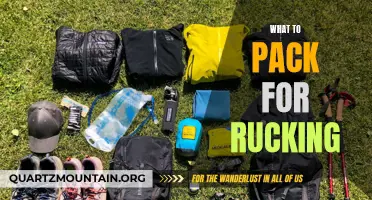
Are you planning a once-in-a-lifetime adventure to climb Mount Kilimanjaro? If so, you'll want to make sure you're fully prepared with the essential packing guide to conquer this formidable peak. Mount Kilimanjaro is the highest mountain in Africa and attracts thousands of climbers each year. To ensure a successful and enjoyable trek, it's crucial to pack the right gear and equipment. From clothing and footwear to camping essentials and first aid supplies, this comprehensive guide will help you navigate the challenging conditions and make the most out of your ascent to the rooftop of Africa. So, let's dive in and discover what you need to pack to conquer Mount Kilimanjaro!
| Characteristics | Values |
|---|---|
| Altitude | 5,895 meters (19,340 ft) |
| Average Temperature | -7 to 20 degrees Celsius |
| Rainfall | Varies by season |
| Terrain | Rocky and rugged |
| Clothing | Layering system |
| Footwear | Sturdy hiking boots |
| Sleeping Bag | Rated for sub-zero temps |
| Backpack | 60-80 liters |
| Water | 3-4 liters per day |
| Food | High-energy snacks |
| Medications | Altitude sickness meds |
| First Aid Kit | Including blister care |
| Sun Protection | Sunscreen and sunglasses |
| Personal Hygiene Items | Wet wipes and hand sanitizer |
| Headlamp | With extra batteries |
| Communication | Cell phone and charger |
| Cash | For tips and emergencies |
| Camera | With spare batteries |
| Trekking Poles | For added stability |
| Maps and Navigation | GPS device or compass |
What You'll Learn
- What clothing items should I pack for a Mount Kilimanjaro trek?
- How many layers of clothing should I bring for varying weather conditions on the mountain?
- Are there any specific gear or equipment items that are essential to pack for Mount Kilimanjaro?
- What type of footwear is recommended for hiking Mount Kilimanjaro?
- Are there any specific personal items or toiletries that I should include in my packing list for Mount Kilimanjaro?

What clothing items should I pack for a Mount Kilimanjaro trek?

If you are planning to embark on the incredible adventure of trekking Mount Kilimanjaro, it is important to pack the right clothing items to ensure your comfort and safety during the expedition. Mount Kilimanjaro, standing at 5,895 meters (19,341 feet) above sea level, poses unique challenges due to its altitude and changing weather conditions.
To begin with, layering is key when it comes to clothing for a Mount Kilimanjaro trek. The temperatures on the mountain can vary dramatically from day to night and between different altitude zones. Layering allows you to add or remove clothing as needed to regulate your body temperature and stay comfortable. Here are the essential clothing items you should pack:
- Base Layer: Start with a moisture-wicking base layer that fits snugly against your skin. This could be a long-sleeve thermal top and bottoms made of synthetic materials or merino wool. Avoid cotton as it retains moisture and can make you feel cold and uncomfortable.
- Mid-Layer: Over your base layer, wear a mid-layer for insulation. This could be a fleece or down jacket that provides warmth without adding too much bulk. Opt for a mid-layer with a full-length zipper for ease of ventilation.
- Outer Layer: Your outer layer should be a waterproof and windproof jacket and pants. Look for a high-quality shell made of Gore-Tex or a similar fabric that offers both breathability and protection from the elements. It is worth investing in a good outer layer to ensure you stay dry and protected in case of rain or snow.
- Trekking Pants: Choose comfortable and durable trekking pants that allow for a full range of motion. Convertible pants with zip-off legs are a great option as they can be easily converted into shorts if the weather gets warmer during the day. Additionally, pack a pair of thermal or long underwear bottoms as an extra layer for colder conditions.
- Headwear: Bring a warm hat that covers your ears to protect against cold temperatures. A buff or neck gaiter is also useful to keep your neck and face warm. Additionally, sunglasses with UV protection and a brimmed hat to shield your face from the sun are essential.
- Gloves: Invest in a good pair of waterproof gloves that provide both insulation and dexterity. It is important to have gloves that enable you to handle trekking equipment and maintain a good grip, while also keeping your hands warm.
- Socks: Pack several pairs of moisture-wicking woolen or synthetic socks. Avoid cotton socks as they retain moisture and can cause blisters. It is recommended to wear a thin liner sock underneath a thicker hiking sock for added comfort and protection.
- Boots: Invest in high-quality, waterproof hiking boots that provide ankle support and a sturdy sole for traction. It is important to break in your boots prior to the trek to avoid discomfort and blisters.
- Underwear: Pack enough moisture-wicking underwear for the duration of your trek. Opt for synthetic materials over cotton for better moisture management.
- Sleeping attire: If you are opting for a multi-day trek with overnight camping, pack a set of warm sleeping attire, including thermal pajamas and socks, to ensure a good night's sleep in cold temperatures.
Remember to pack lightweight and compressible clothing items to maximize space in your backpack. It is recommended to consult with experienced trekkers or guides who have done the Mount Kilimanjaro trek before, as they can provide valuable insights and recommendations specific to the trek.
In conclusion, packing the right clothing items for a Mount Kilimanjaro trek is crucial for your comfort and safety. Layering, moisture-wicking materials, and waterproof outerwear will help you adapt to changing weather conditions and stay dry. Investing in high-quality gear will ensure durability and protection throughout the expedition. So, pack wisely and enjoy the incredible journey to the summit of Mount Kilimanjaro!
Essential Items to Pack for Backpacking in Mexico
You may want to see also

How many layers of clothing should I bring for varying weather conditions on the mountain?

When venturing into the mountains, it is essential to pack the right amount of clothing to ensure your comfort and safety in varying weather conditions. The number of layers you bring will largely depend on the climate, season, and the specific activities you plan to engage in. Here, we will provide a step-by-step guide to help you determine how many layers of clothing you should bring for different weather conditions.
Step 1: Check the Weather Forecast
Before embarking on your mountain adventure, always check the weather forecast for the specific region you will be in. This will give you a general idea of the expected temperatures, precipitation, and wind conditions. Be sure to check the forecast for the duration of your trip to anticipate any changes in weather patterns.
Step 2: Consider the Season
The clothing requirements for the mountains can vary greatly depending on the season. In colder months, such as winter, you will need more layers to protect yourself from frigid temperatures and possible snowfall. In warmer seasons, such as summer or spring, you may need fewer layers but should still be prepared for cooler evenings or sudden weather changes.
Step 3: Assess the Activity Level
The number of layers you need will also depend on the activities you plan to undertake. For high-intensity activities like hiking or climbing, you may generate more body heat and, therefore, require fewer layers. On the other hand, if you plan to engage in more stationary activities like fishing or camping, you may need more layers to stay warm.
Step 4: Follow the Three-Layer System
A commonly recommended clothing system for the mountains is the three-layer system. This system consists of a base layer, an insulating layer, and an outer shell layer.
- Base Layer: The base layer is the foundation of your clothing system. It should be made of moisture-wicking material that helps move sweat away from your body, keeping you dry and comfortable. Depending on the temperature, you may opt for either lightweight or heavyweight base layers.
- Insulating Layer: The insulating layer provides warmth by trapping air close to your body. This layer can be a fleece or down jacket or a combination of both. The thickness and insulation level should be chosen based on the anticipated temperatures. You can add or remove insulating layers as needed.
- Outer Shell Layer: The outer shell layer acts as a barrier against wind, rain, and snow. It should be windproof, waterproof, and breathable to keep you protected and comfortable. This layer can be a durable shell jacket or a soft shell jacket, depending on the weather conditions.
Step 5: Bring Additional Accessories
In addition to the three-layer system, it is important to bring along some accessories to further regulate your body temperature. These may include a hat, gloves or mittens, neck gaiter, scarf, and extra pairs of socks. These accessories can easily be removed or added to adapt to changing weather conditions.
Examples:
- If you are planning a winter hike in the mountains where the temperature is expected to be below freezing, you may opt for a heavyweight base layer, a thick insulating layer, and a durable shell jacket to protect against wind and snow.
- For a summer camping trip in the mountains, you might choose a lightweight base layer, a medium-weight insulating layer, and a soft shell jacket for possible cooler evenings or unexpected rain showers.
Remember, it is always better to pack extra layers and accessories rather than finding yourself underprepared for unexpected weather changes. By considering the weather forecast, season, activity level, and following the three-layer system, you can ensure you are properly dressed to handle varying weather conditions on the mountain.
The Essential Family Vacation Packing Checklist: Don't Leave Home Without These Items
You may want to see also

Are there any specific gear or equipment items that are essential to pack for Mount Kilimanjaro?

When it comes to climbing Mount Kilimanjaro, proper gear and equipment can make all the difference. The mountain is known for its unpredictable weather conditions and extreme altitude, so it is crucial to pack the right items to ensure a safe and successful climb. Here are some essential gear and equipment items that should be on every climber's packing list:
- Hiking boots: A good pair of hiking boots is essential for navigating the rugged terrain of Mount Kilimanjaro. Look for boots that provide ankle support and have a sturdy sole for traction on slippery slopes.
- Layered clothing: The weather on Mount Kilimanjaro can vary greatly, so it is important to pack clothing that can be easily layered. This allows you to adjust your clothing according to the temperature and weather conditions. Start with a moisture-wicking base layer, add a warm mid-layer, and finish with a waterproof and windproof outer layer.
- Sleeping bag: A warm and lightweight sleeping bag is crucial for a comfortable night's rest on the mountain. Look for a bag that is rated for temperatures below freezing, as temperatures at night can drop well below zero on Kilimanjaro.
- Trekking poles: Trekking poles provide stability and reduce strain on your joints while hiking on steep and uneven terrain. They also help to distribute the weight of your backpack more evenly, making it easier to carry.
- Headlamp: A headlamp is essential for early morning and late-night hikes. It allows you to have a hands-free light source, which is particularly useful when navigating in the dark.
- Water bottles or hydration bladder: Staying hydrated is crucial while climbing Kilimanjaro. It is recommended to drink at least 3-4 liters of water per day. Pack water bottles or a hydration bladder that can hold enough water for a day's hike.
- Sun protection: The sun's rays can be harsh at high altitudes, so it is important to protect yourself from sunburn and potential sun damage. Pack sunscreen with a high SPF, a wide-brimmed hat, sunglasses, and lip balm with SPF.
- Snacks and energy gels: Climbing Mount Kilimanjaro requires a lot of energy, so it is important to have easy-to-eat snacks and energy gels on hand. These can provide a quick boost of energy when needed.
- First aid kit: It is always a good idea to have a basic first aid kit with you while climbing Kilimanjaro. Include items such as bandages, pain relievers, blister pads, and any necessary medication.
- Backpack: A sturdy backpack with a comfortable harness system is essential for carrying all your gear and equipment. Look for a backpack that is large enough to hold all your essentials but light enough to carry comfortably.
It is important to note that Mount Kilimanjaro is a challenging and potentially dangerous climb. Before attempting the climb, it is recommended to consult with a professional guide and undergo proper training and preparation. Additionally, make sure to check the latest gear and equipment requirements and recommendations from experienced climbers and mountaineering organizations.
Essential Items to Pack for the J1 Program: Your Complete Guide
You may want to see also

What type of footwear is recommended for hiking Mount Kilimanjaro?

Mount Kilimanjaro is one of the most popular hiking destinations in the world. It is a challenging trek that requires proper preparation to ensure a successful summit. One crucial aspect of this preparation is selecting the right footwear for the journey. The right hiking boots can make a significant difference in your comfort and safety on the mountain.
When choosing footwear for hiking Mount Kilimanjaro, it is essential to prioritize functionality over fashion. The terrain on the mountain varies greatly, from rocky trails to steep ascents and descents. Therefore, your shoes need to provide excellent traction, stability, and support.
Ideally, you should opt for hiking boots that are specifically designed for high-altitude and multi-day treks. These boots typically feature a sturdy construction, ankle support, and a durable sole. Look for boots made from waterproof materials, such as Gore-Tex, to keep your feet dry in case of rain or snow.
It is crucial to try on several pairs of hiking boots before making a final decision. Different brands and models have varying fits, and it is important to find a pair that feels comfortable on your feet. When trying on boots, wear the same type of socks you intend to use on the trek to ensure a proper fit. It is advisable to go up a half or full size from your regular shoe size to accommodate for foot swelling that can occur at high altitudes.
The break-in period for hiking boots is also important. It is essential to wear your new boots on multiple hikes and walks before attempting to climb Kilimanjaro. This helps your feet adjust to the boots and minimizes the risk of blisters or discomfort during the trek.
In addition to hiking boots, it is also recommended to bring a pair of sandals or lightweight shoes for camp. Once you reach your overnight campsite, you will want to give your feet a break from the boots and allow them to breathe. Sandals can also be useful for short hikes around the camp or for crossing streams.
To summarize, when it comes to footwear for hiking Mount Kilimanjaro, prioritize functionality over fashion. Choose high-quality hiking boots designed for high-altitude treks and ensure a proper fit. Invest time in breaking in your boots before the trek and consider bringing a pair of sandals for comfort at the campsites. By selecting the right footwear, you can enhance your comfort and safety during your Kilimanjaro adventure.
Essential Items to Pack for a Trip to Brampton
You may want to see also

Are there any specific personal items or toiletries that I should include in my packing list for Mount Kilimanjaro?

When preparing for a trek up Mount Kilimanjaro, it's important to pack carefully and include all the necessary items to ensure a comfortable and successful climb. Besides the obvious essentials like clothing and gear, there are also a few personal items and toiletries that you should consider adding to your packing list. These items may not be critical for your survival on the mountain, but they can greatly improve your comfort and overall experience.
- Wet wipes: On the mountain, water is limited and often scarce. Wet wipes can be a great alternative to traditional bathing and can help you feel refreshed throughout the journey. Look for biodegradable wipes to minimize your impact on the environment.
- Toilet paper: Although some campsites on the mountain may provide toilet paper, it's always good to have your own supply. Choose a small, compact roll that can easily fit in your backpack.
- Hand sanitizer: Keeping your hands clean is crucial for maintaining good hygiene on the mountain. Pack a small bottle of hand sanitizer and use it frequently, especially before meals or after using the bathroom.
- Sunscreen: The sun's rays can be intense at high altitudes, and it's important to protect your skin from harmful UV radiation. Choose a high SPF sunscreen and apply it generously to exposed skin, including your face, neck, and hands.
- Lip balm: The cold, dry air on the mountain can quickly lead to chapped lips. Bring a lip balm with SPF to protect and moisturize your lips throughout the climb.
- Moisturizer: The combination of high altitude and extreme temperatures can be harsh on your skin. Bring a lightweight moisturizer to keep your skin hydrated and prevent dryness and cracking.
- Medications and personal care items: If you take any prescription medications, be sure to pack an ample supply for the duration of your climb. Additionally, bring any personal care items you may need, such as contact lens solution, feminine hygiene products, or any other personal items that are necessary for your comfort.
- Towel: While most campsites provide some form of towel or hand towel, it's always good to have your own. Look for a lightweight, quick-drying towel that won't take up too much space in your backpack.
- Toothbrush and toothpaste: Although basic dental hygiene may not be top priority on the mountain, it's still important to take care of your teeth. Pack a small travel-sized toothbrush and toothpaste to keep your oral health in check.
- Hair ties or headband: If you have long hair, consider bringing some hair ties or a headband to keep your hair out of your face during the climb. This can help prevent irritation and improve your overall comfort.
Remember, when packing for Mount Kilimanjaro or any other high-altitude trek, it's important to prioritize lightweight, compact items. Keep in mind that every extra ounce adds up, so consider the weight and size of each item before adding it to your packing list. By including these personal items and toiletries, you can enhance your comfort and overall experience on your journey to the top of Mount Kilimanjaro.
Essential Items to Pack for Studying Abroad in Granada, Spain
You may want to see also
Frequently asked questions
It is important to pack layers of clothing for Mount Kilimanjaro, as the temperatures can vary greatly throughout the day. You will need a base layer of moisture-wicking material, a warm mid-layer for insulation, and a waterproof and windproof outer layer. It is also important to pack thermal socks and gloves, as well as a hat and sunglasses to protect yourself from the sun.
Yes, you will need to bring your own sleeping bag for Mount Kilimanjaro. It is recommended to bring a sleeping bag rated for temperatures below freezing, as the temperatures at higher altitudes can drop significantly at night. Make sure your sleeping bag is also lightweight and compact, as you will need to carry it with you during the trek.
It is important to have sturdy and comfortable footwear for hiking Mount Kilimanjaro. You will need a pair of hiking boots that are broken in and provide good ankle support. It is also recommended to bring a pair of gaiters to protect your boots and lower legs from dust, debris, and rain.
Some important personal items to pack for Mount Kilimanjaro include sunscreen, mosquito repellent, a headlamp or flashlight, and toiletries. You should also bring a reusable water bottle, as it is important to stay hydrated during the trek. Additionally, pack any necessary medication and a first aid kit with basic supplies, such as bandages, pain relievers, and blister treatment.
There are some items you should avoid bringing on your Mount Kilimanjaro trek. Avoid bringing unnecessary electronics, as they can be heavy and may not be functional at higher altitudes. It is also recommended to not bring too much clothing, as it can be difficult to carry and you may not need all of it. Finally, avoid bringing valuables, as there is a risk of loss or theft during the trek.







